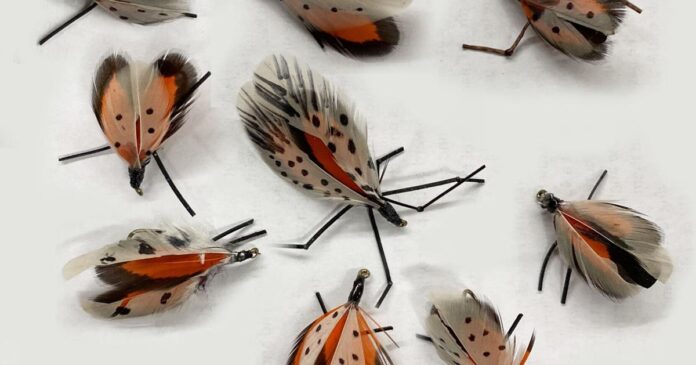The spotted lanternfly appears to be yet another invasive insect with Asian origins that have found their way to the United States. The onslaught of the spotted lanternfly is on the heels of a list of other invasive insects, including the emerald ash borer, the woolly adelgid and the gypsy moth. Each of these invaders have had devastating effects on the eastern forests, and the spotted lanternfly is on a similar pattern of destruction.
Spotted lanternflies pose a real threat to American agriculture and natural resources. Since it was first noticed in Berks County, Pennsylvania, in 2014, the spotted lanternfly has been wreaking havoc on the lumber, tree fruit and wine industries. Spotted lanternfly populations are currently found in 14 states, including Connecticut, Delaware, Indiana, Maryland, Massachusetts, Michigan, New Jersey, New York, North Carolina, Ohio, Pennsylvania, Rhode Island, Virginia, and West Virginia.
An adult spotted lanternfly is approximately one inch in length with a wingspan of around two inches. Lanternflies resemble moths and are clumsy fliers. They crawl on six legs and hop like a grasshopper when frightened. They do not light-up like a lightning bug but were named because of their lantern-like shape in flight. Fortunately, spotted lanternflies are harmless to humans. They do not bite, but they are equipped with a siphon like mouth used to suck juices from plants and trees.
According to a 2020 report in Scientific American, spotted lanternflies feast on more than 70 plant species and leave behind “honeydew” droppings, which attract wasps and other stinging insects and which breed a black, sooty mold that can significantly damage plants. The mature insects die in the cold, but their egg masses, which can hold between 30 and 50 eggs and look like a grayish putty, withstand winter temperatures and release a new generation in the spring.
I first encountered an infestation of spotted lanternflies in Thurmont this past summer while helping my neighbor by removing an unwanted tree in their yard. Ailanthus altissim is an invasive tree commonly known as tree-of-heaven and just happens to be the preferred host for spotted lanternflies. The tree trunk was covered with a congregation of several dozen insects. After felling the tree, I was able to squash all of the invaders quite easily as they did not take to flight and were easy targets for my size 11 boots.
Tying the spotted lanternfly pattern
Interestingly, a local fishing club has found a unique way to tackle the problem. The Potomac Valley Fly Fishers believe fly anglers can take advantage of the multitude of adult spotted lanternflies that get blown by winds into waterways by creating a fly pattern that resembles these pests. If the spotted lanternflies have the same appeal to hungry fish as the Brood X periodical cicadas did in 2021, fly tyers will be in business.
The Potomac Valley Fly Fishers host a beginning and advanced fly tying class each month at the Trinity United Methodist Church in Frederick. The spotted lantern fly was the chosen fly pattern at the January meeting of the advance fly tying session led by Don and Ruby Fine. A total of twelve members attended the class in person, while a camera and monitor was used for those who chose to attend virtually.
The Fines are well known locally as capable teachers and expert fly tyers. They have been offering free fly tying classes now for more than a decade. All the materials needed for the attendees as well as a written list of the materials used with step-by-step instruction are provided to attendees.
The challenge
The goal was to create a fly that resembles a spotted lanternfly enough to fool a hungry fish while using time and resources efficiently. Tying a spotted lanternfly pattern presented an elevated challenge as there exist few examples when compared to tried and true terrestrial fly patterns that often imitate grasshoppers, crickets and beetles.
The fly pattern Don chose was derived from a lantern fly pattern posted online by Holsinger’s Fly Shop in Blair County, Pennsylvania. As a creative and innovative fly tyer, Don is a master at using the materials at hand to suit his needs aptly.
I would like to report that the finished products created that night seem to fit the bill. Member Larry Forte challenged all to be the first to catch a fish on their spotted lantern fly creations. A catch documented and shared will attribute well-deserved bragging rights to the angler.
Learn to tie
The Potomac Valley Fly Fishers extend an invitation to anyone interested in learning how to tie flies to join in. No experience is necessary and all materials and tools are provided for the beginner’s class. This class meets the third Tuesday of every month at 7 p.m. at the Trinity United Methodist Church in Frederick. The advanced fly tying class meets at the same location and time on the third Wednesday of each month. For those who prefer to join via ZOOM, there is a Zoom hook-up for the advanced fly tying session only.
You can watch recorded fly tying session hosted by Don Fine on youtube at:































